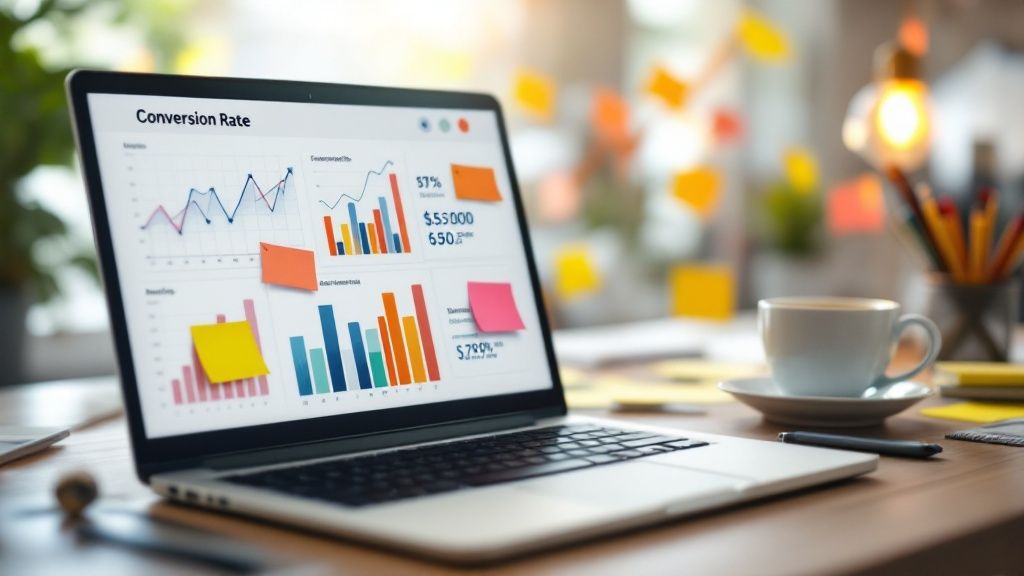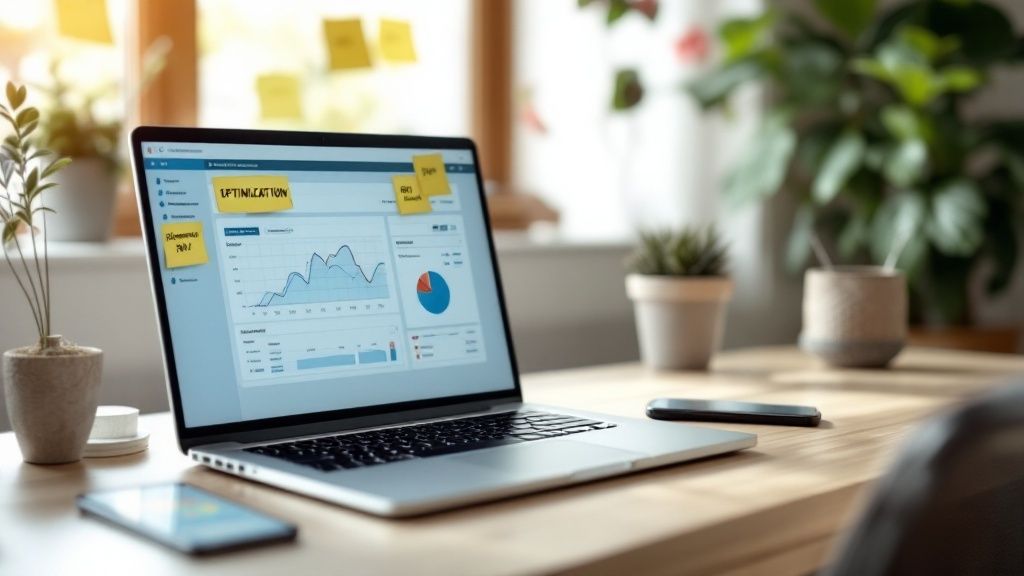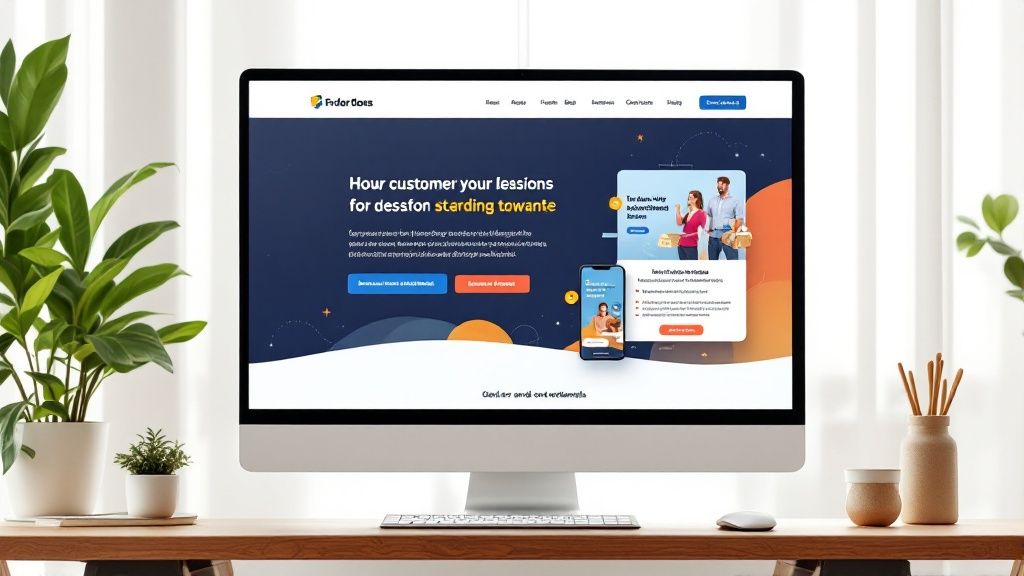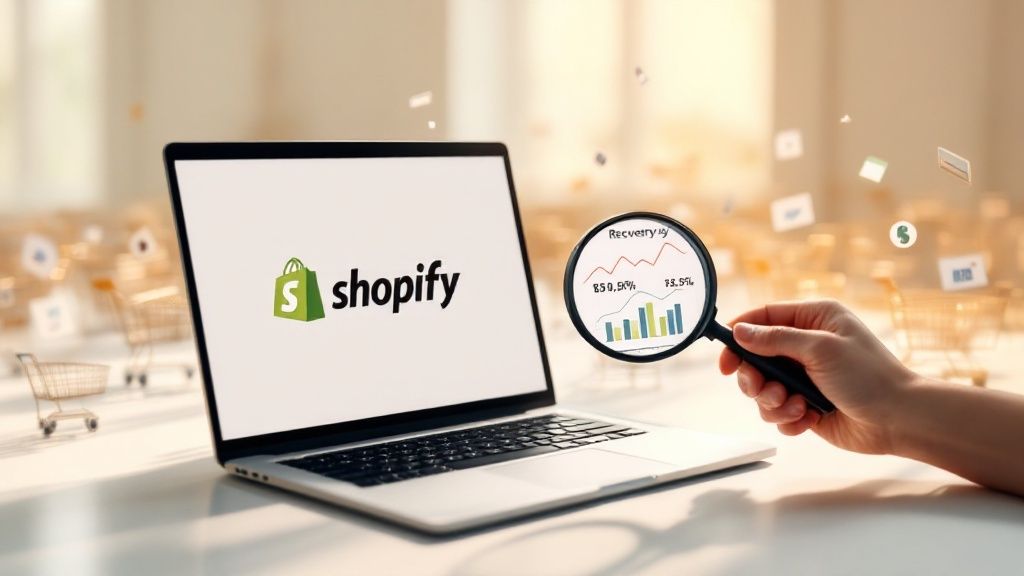How to Increase Conversion Rate: The Complete Guide to Higher Converting Websites
January 22, 2025

Understanding the Psychology Behind Conversion Success

The secret to better conversion rates lies in understanding what makes your audience tick. When you grasp the psychology behind how people make decisions, you can create experiences that truly connect with their needs. Just look at Expedia, who saw their profits jump simply by making their checkout process more straightforward. This small change shows just how much impact understanding user behavior can have.
The Power of Simplicity and Clarity
Simplicity is essential for converting visitors into customers. When a website is cluttered or confusing, people quickly click away. Your messaging should be crystal clear, your navigation intuitive, and your design clean and focused. Make your call-to-action buttons stand out and compelling – they should naturally guide visitors toward taking the next step.
Building Trust and Credibility
People need to trust you before they'll buy from you. This is where social proof becomes your best friend. Real customer reviews, detailed case studies, and authentic testimonials help potential customers feel confident in their choice. Adding trust badges and security seals, especially during checkout, helps reduce anxiety about making purchases online. For more insights, check out this guide on ecommerce conversion optimization.
Creating a Sense of Urgency
While trust forms the foundation, a well-placed sense of urgency often provides the final push toward conversion. Special time-limited offers or highlighting product scarcity can motivate people to act now rather than later. The key is keeping it real – any urgency tactics should offer genuine value to customers. False pressure only damages trust and hurts long-term relationships.
Personalization and Targeting
Generic messages rarely grab attention or drive action. By adjusting your content, offers and design to match different visitor groups' specific needs and interests, you can significantly boost conversion rates. When people feel understood and see content that speaks directly to them, they're much more likely to engage and convert.
Mastering the Art and Science of A/B Testing
A/B testing gives you concrete data about what works on your website. By systematically testing different elements against each other, you can understand exactly what drives visitors to take action and make purchases. Think of it as running small experiments to steadily improve your site's performance.
Identifying Your Most Impactful Testing Opportunities
Smart A/B testing starts with finding the right opportunities on your site. Look at your analytics to spot pages with high traffic but low conversions – these are prime testing candidates. For instance, if your product pages get lots of views but few sales, that's a clear signal to test different approaches. Focus your testing efforts on the changes that could have the biggest impact on your goals.
Executing Flawless A/B Tests
Good A/B tests need careful planning. Start by writing down what specific changes you think will improve conversions and why. Then create variations that change just one element at a time – whether it's a headline, image, button, or page layout. This focused approach makes it crystal clear which changes actually make a difference.
Avoiding Common A/B Testing Pitfalls
Many site owners make the mistake of ending tests too quickly before getting meaningful data. Another frequent error is changing multiple things at once, which makes it impossible to know what worked. A/B testing on landing pages typically increases conversions by 12% when done right. For example, when Bing tested different ad headlines, they saw a 12% jump in revenue. Find more detailed statistics here.
Building a Continuous Improvement Cycle
A/B testing works best as an ongoing process, not a one-time project. Keep testing different elements regularly and learn from both successful and unsuccessful tests. These insights help you understand your audience better and guide future improvements. Over time, small wins add up to major gains in conversion rates.
Scaling Your Testing Program
As you get more experience with testing, expand to run tests across multiple pages and visitor segments. You might show different headlines to new versus returning visitors, for example. Testing specific messages for different audience groups often leads to even better results. The key is to keep refining your approach based on real data about what your visitors respond to.
Transforming Website Performance Through Speed Optimization

Fast website loading speeds can make or break your online success. Think about visiting a physical store – would you stay and shop if you had to wait several minutes just to enter? The same principle applies online. When visitors can quickly access and navigate your site, they're more likely to stay, engage, and convert into customers.
The Impact of Speed on Conversions
The numbers tell a compelling story about website speed and business results. According to recent studies, improving your load time by just one second can boost conversions by 7%. Even more impressive, sites that load in under two seconds see conversion rates increase by 15%. This direct connection between speed and sales makes optimization essential for any business. For more insights, check out these conversion rate statistics from Shopify.
Identifying Performance Bottlenecks
Finding what slows down your site is the first step to improvement. Website speed testing tools can pinpoint specific issues dragging down performance. Common problems include oversized images, bloated code files, and too many server requests. These technical hurdles prevent visitors from smoothly moving through your site toward making a purchase.
Implementing Speed Improvements
Start with the basics – optimize your images. Modern compression tools can significantly reduce file sizes while keeping visual quality intact. Next, look at combining files and using browser caching to minimize data transfers. Small technical tweaks can add up to major speed gains that visitors will notice.
Measuring Speed's Impact
Keep track of your progress through regular speed tests and analytics reviews. Watch key metrics like bounce rates and conversion rates to see how your optimizations affect real user behavior. This data helps you focus on changes that deliver the best results. With consistent monitoring and refinement, you can build a faster site that converts more visitors into customers.
Harnessing Buyer Intent Data for Strategic Conversion Wins
Understanding what your website visitors want is essential for improving conversion rates. By analyzing visitor behavior and intentions, you can provide relevant experiences that keep them engaged and guide them toward conversion. Let's explore how buyer intent data can help optimize your conversion strategy.
Identifying High-Intent Segments
Just as a skilled salesperson can spot a serious buyer, analyzing user behavior helps identify visitors most likely to convert. By looking at factors like pages visited, time on site, and purchase history, you can segment visitors based on their likelihood to take action. This allows you to focus your efforts on the most promising leads. For instance, someone spending significant time reviewing pricing details shows much stronger buying signals compared to a casual blog reader. With these insights, you can deliver targeted messages and offers to high-intent visitors.
Creating Dynamic Experiences
Once you've identified your high-intent segments, the next step is crafting experiences that match their needs. Dynamic content that adapts to individual behavior is key here. This could mean showing relevant pop-up offers, suggesting related products based on browsing patterns, or adjusting navigation to guide visitors toward conversion. When visitors receive personalized experiences that align with their interests, they're more likely to become customers.
Combining Data Sources for a Complete Picture
Getting a clear view of buyer intent requires connecting multiple data points. Website analytics, CRM data, social interactions, and third-party intent signals all provide valuable clues about visitor motivations. Think of it like detective work – the more evidence you gather, the better you understand your visitors' goals. For example, Lift AI helps businesses analyze user data in real-time to predict buyer intent and engage visitors more effectively. RFP software company Loopio used this approach to identify and connect with their most promising leads. Learn more about conversion rate optimization here.
Measuring and Scaling Your Success
Tracking metrics is crucial for improving your intent-based optimization efforts. Focus on key indicators like conversion rates, average order value, and customer lifetime value. This data shows which personalization strategies work best and where you can improve. As you refine your approach, expand successful tactics across the full customer journey – from initial visit through post-purchase engagement. A consistent personalized experience keeps customers coming back while attracting new ones through proven methods.
Crafting Landing Pages That Convert at Scale

Landing pages make or break your ability to convert visitors into customers. A well-designed landing page can significantly boost conversions, while poor design will send potential customers running. Understanding what makes landing pages effective is essential for growing your business and scaling your marketing campaigns successfully.
Designing for Emotional Connection and Clarity
The best landing pages speak directly to visitors' emotions while maintaining a clear purpose. This starts with understanding your buyer persona – what drives them, what keeps them up at night, and what solutions they're seeking. For example, if you sell accounting software, focus on how it relieves tax season stress rather than just listing features. Keep the design clean and simple, naturally drawing attention to your call-to-action (CTA).
Crafting Compelling Copy That Resonates
Strong copy is just as crucial as good design. Your words should clearly communicate value while addressing common objections head-on. Build trust through customer testimonials and social proof that show real results. The goal is to make visitors feel confident in taking the next step. For more insights, check out: How to master Shopify landing page design.
Structuring for Conversion: Guiding the Visitor's Journey
A high-converting landing page naturally guides visitors toward taking action. Start with an attention-grabbing headline that highlights your main benefit. Follow with supporting sections that build your case and reinforce value. Place clear CTAs strategically throughout to capture visitors when they're ready to convert.
| Element | Best Practice |
|---|---|
| Headline | Clear, concise, and benefit-driven |
| Body Copy | Persuasive, focused on value, addressing objections |
| Call-to-Action | Prominent, clear, and strategically placed |
| Visuals | High-quality, relevant, and supporting the message |
| Social Proof | Testimonials, reviews, and trust badges |
Testing and Optimizing for Continuous Improvement
Creating effective landing pages requires ongoing testing and refinement. Use A/B testing to try different headlines, CTAs, and visuals to see what works best. But don't test randomly – start with a clear hypothesis about what might improve conversions and measure the results carefully. This data-driven approach helps maintain strong performance as you scale your marketing efforts.
Designing Call-to-Action Strategies That Drive Action

Every successful website needs an effective call-to-action (CTA) that converts visitors into customers. CTAs serve as the critical connection point between engaging content and meaningful action. Creating CTAs that truly work requires mastering both persuasive messaging and smart design choices.
The Psychology of Persuasion: Crafting Irresistible CTAs
The best CTAs connect with what people want and need. Rather than using generic text like "Sign Up," try specific phrases that highlight clear value, such as "Start Your Free Trial" or "Get Your Custom Quote." This makes the offer feel more relevant and worthwhile to each visitor. Adding time-sensitive elements like "Limited Time Offer" can help motivate action without being pushy.
Button Design: Visual Cues That Convert
The visual design of your CTA button needs just as much attention as the message. Make buttons stand out with colors that contrast against the page background. Use clear, readable text and ensure buttons are large enough to tap easily on mobile devices. Simple A/B tests of different designs often reveal surprising insights – even small changes like rounded corners can boost click rates significantly.
Placement Optimization: Guiding the User's Journey
Smart CTA placement follows the natural flow of your content. While prominent above-the-fold placement works well for landing pages, don't stop there. Adding CTAs after key benefits or features catches visitors when they're most interested. This creates multiple natural opportunities for conversion as people explore your page.
Message Testing: Refining Your Approach
Never assume your first CTA version is the best it can be. Run A/B tests to compare different messages, designs and placements. Let data guide your choices. For example, one company saw a 20% jump in conversions just by changing their button from green to orange. Keep testing different options to find what truly connects with your audience.
Maintaining High Click-Through Rates as You Scale
As your site grows, keep CTAs relevant through smart personalization. Show different messages to new versus returning visitors. Adjust CTAs based on past behavior and preferences. This targeted approach helps maintain strong engagement even as your audience expands.
Ready to make your checkout process smoother and boost sales? See how personalized, shoppable links can help. Start your free trial today!
 Checkout Links
Checkout Links



